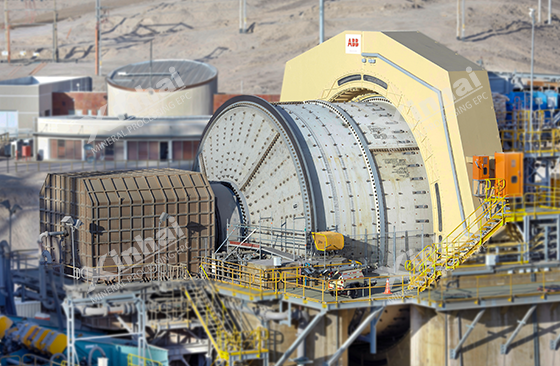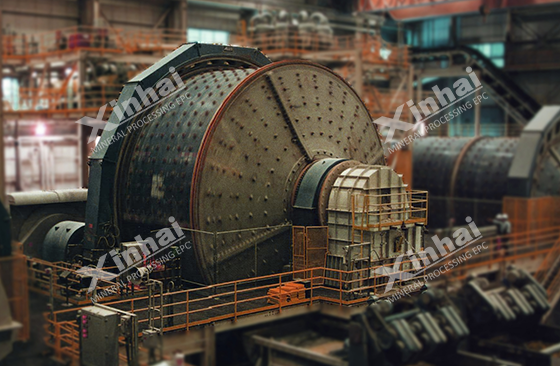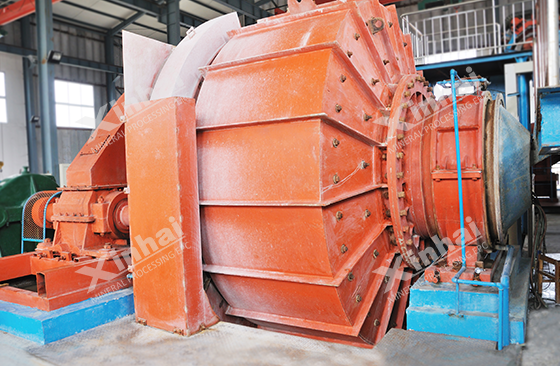
As one of the important technologies for mineral processing, autogenous grinding process has become a key means to improve ore crushing efficiency and reduce energy consumption. By using the ore itself as an abrasive, autogenous grinding equipment achieves efficient grinding operations, while reducing dependence on external abrasives, reducing environmental pollution and cost expenditures. This article will discuss the types of autogenous grinding processes and the common autogenous grinding technologies in the mineral processing process to help you better optimize the mineral processing process.

According to the number of milling stages, process adjustment methods and strengthening means of ore autogenous grinding, the autogenous grinding process can be divided into the following types:
(1) Full autogenous grinding: It can be divided into one-stage full autogenous grinding and two-end full autogenous grinding process.
A. One-stage full autogenous grinding: The raw ore is subjected to rough grinding and then enters the autogenous grinding mill for one-time grinding to the requirements of ore dressing. The ore itself is used as the grinding medium during grinding.
B. Two-end full autogenous grinding: The ore is autogenously ground in the first stage, and the second stage of the grinding process uses a gravel mill for fine grinding until the ore particle size meets the requirements of ore dressing.
(2) Semi-autogenous grinding process: It can be divided into one-stage semi-autogenous grinding and two-stage semi-autogenous grinding processes. In the one-stage semi-autogenous grinding processing, a small amount of steel balls will be added as the medium to strengthen the grinding processes. In the two-stage semi-autogenous grinding processes, the first grinding adopts autogenous grinding, while the second stage adopts ball milling, or the first stage adopts semi-autogenous grinding processes and the second stage adopts ball milling.
(3) Intermediate autogenous grinding process: The subsequent products are screened to select some coarse-grained ore particles as the grinding medium for autogenous grinding. The remaining coarse crushed products continue to be crushed in the middle and fine crushing. After the ore particle size meets the feed particle size of the general ball mill, it is fed into the autogenous mill for processing.
Depending on whether there are control classification or inspection classification processes in the autogenous grinding process, each autogenous grinding processes can be divided into three types: open circuit, closed circuit, and semi-closed circuit.

When processing ores with medium hardness or below, the particle size of the grinding product is required to be coarse. When the proportion of -200 mesh ores is about 60%, a one-stage closed-circuit autogenous grinding processes can be used. In order to control the particle size of the autogenous grinding product, the one-stage autogenous grinding is a closed-circuit method with inspection and control classification. The equipment used for inspection and classification includes drum screens, vibrating screens, curved screens, spiral classifiers, etc. In addition to spiral classifiers, hydrocyclones can also be used for control classification. The characteristics of this process are simple process flow, simple configuration, and full use of the advantages of autogenous grinding technology.
When the ore selection requires that the proportion of -200 ore particles in the grinding product is more than 70%, the two-end semi-autogenous grinding processes can be adopted. The first stage of the autogenous grinding equipment works under closed circuit conditions or open circuit conditions. The second stage of grinding can use a ball mill or a gravel mill. The second stage of grinding process generally works under closed circuit conditions.

After the raw ore is coarsely crushed, the ore particles with a particle size of more than 150mm are selected through screening as autogenous grinding media. These media are fed into the autogenous mill in a certain proportion for grinding. The autogenous grinding media generally accounts for about 15-30% of the raw ore, mainly depending on the nature of the ore. The products under the screen are medium and fine crushed, and after being crushed to -20mm, they enter the autogenous mill for grinding. The feed particle size of the autogenous mill and the size and quantity of the medium particle size can be controlled. The characteristic of this process is that the ore that is difficult to handle by autogenous grinding can be excluded first, thereby improving the efficiency of autogenous grinding.

The above are the types of autogenous grinding processes and the autogenous grinding processes commonly used in mineral processing plants. The application of autogenous grinding technology in the mineral processing process has brought far-reaching impacts to the mining industry. By effectively improving the ore grinding efficiency and reducing energy consumption, it has laid a solid foundation for the subsequent processing and utilization of the ore. In order to meet the requirements of the mineral processing plant, the appropriate autogenous grinding machine and autogenous grinding process should be selected according to the properties of the ore, so as to maximize the utilization of mineral resources and improve the production efficiency of the mineral processing plant.
To find out more about our products and solutions, please fill out the form below and one of our experts will get back to you shortly.